One of the early potential competitors to the Maxim gun was the Austro-Hungarian Salvator-Dormus machine gun. Designed by Austrians Grand Duke Karl Salvator and Colonel von Dormus, is was first patented in 1888, although it has come to be known as the model 1893 because this was when the Austro-Hungarian Navy adopted it. Also known as the Skoda machine gun (by virtue of being manufactured by the Skoda works), the design is an interesting mix of both obsolete and forward-looking elements.
At a basic mechanical level, the Salvator-Dormus is a delayed blowback action, using mechanical disadvantage of a lever combined with the friction of a fast-threaded screw and a heavy spring. It was chambered for the 8x50R cartridge, which was a smokeless-powder modern cartridge used at the time in the Austrian infantry rifles – so this is a true full power cartridge (244gr / 16g round nose bullet moving at about 2,000 fps / 610 mps).
When fired, the recoil energy acted on the breechface, which has a shape roughly similar to that of an oversize revolver hammer. A supporting block held the breechface in place against the chamber such that the force of firing would push it out of the way slowly, redirecting most of the recoil energy. The resistance to opening was provided by a carefully engineered lever effect acting on a spring and a fast-threaded screw. Thus in order for the support block to move, the screw had to thread into its housing (which generated friction and slowed down the process) and do so against the force of the recoil spring (further slowing the process). The result was that the breech did not open until the pressure in the bore had dropped to a safe level. This cutaway example makes the system much clearer:
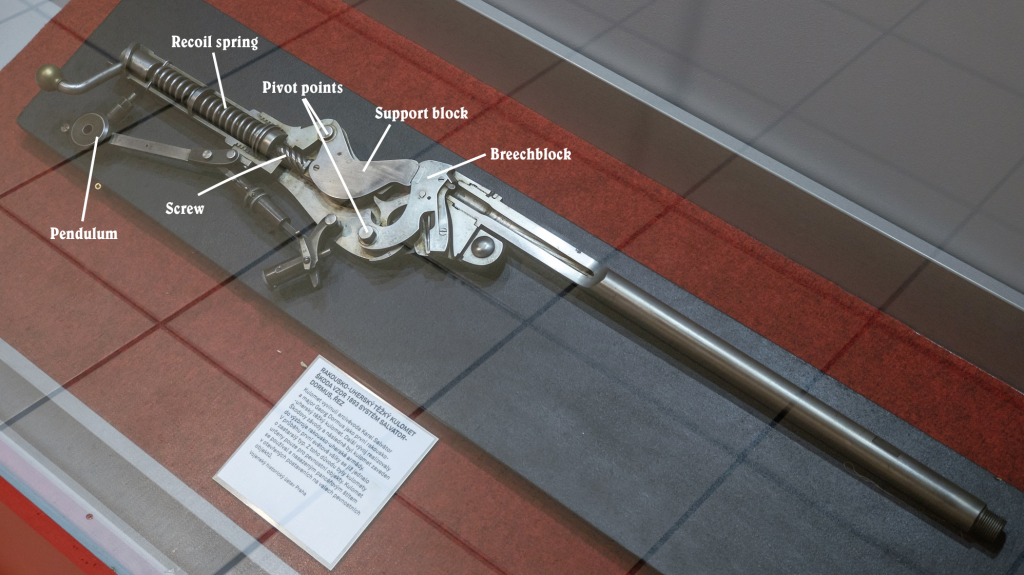
A couple additional elements to describe are the pendulum below the action, and the handle at the back of the recoil spring. The handle is simple; that is used to manually charge the action, as there is no other lever allowing manipulation of the internal parts. The pendulum is a bit more complex and certainly less common – it is used to adjust the rate of fire. That weighed pendulum swings back and forth with the action as each shot is fired, and as the weight is made heavier and/or mounted lower on the stalk, the amount of inertia in the pendulum increases, thus retarding the rate of fire. That was its purpose; to allow the rate of fire to be adjusted manually. The cutaway is a bit misleading in this regard, as it shows the pendulum in the breech-fully-open position, while the breech is actually closed.
Using this mechanism, the rate of fire could be set as low as 175 rpm and as high as 500 rpm (according to US military trials of 1894, as quoted by Chinn).
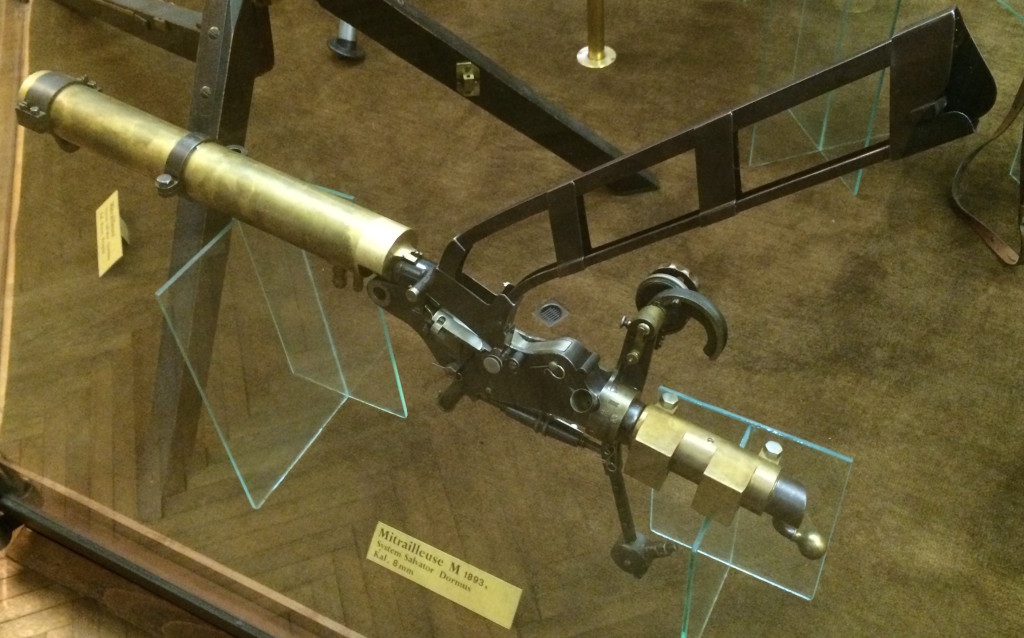
The feed system for the Salvator-Dormus was one of its anachronistic elements – it used a gravity-feed single-stack hopper. As seen in the photo above, a tall skeletonized feed tower was mounted atop the gun, and an assistant gunner would refill it as the gun was fired. Reportedly clips were made used a spring catch to hold cartridges securely and which fit over the top of the feed tower – which would push the retention spring out of the way and allow the cartridges to drop into the gun’s feed tower. This was a system which would actually turn out to work for the Salvator-Dormus, although it was not suitable to infantry use and would not be adopted by any other military machine gun after this date.
One are of foresight in the Salvator-Dormus was its water jacket. Where the Maxim gun and most of its competitors used a simple fill-and-drain water jacket, the Salvator-Dormus was designed for use with a circulating pump. This could allow a constant supply of fresh cold water to keep the guns cool without generating a telltale steam cloud or running dry in extended firing.
The gun was formally adopted by the Austro-Hungarian Empire, but used for naval and fortification defense and not infantry service (which makes sense, given its design limitations). At least one of the guns did see combat, as they were mounted on the Austro-Hungarian battle cruiser Zenta when it was deployed to Peking during the Boxer Rebellion. Reportedly the guns were remarkably reliable and durable, with one test-firing session running for 9 minutes without a stoppage. That may not be Maxim-level reliability, but it is still quite good for the era.
The Salvator-Dormus was tested by the US military in 1894, although only 600 rounds were available to use so the affair was more of an introduction or familiarization that a true trial. The US report found no direct flaws, but comments that the mechanism did not appear to be sturdy enough for the rigors of field use. Given the Austro-Hungarian limitation to ships and fortresses, that was probably a valid assessment.
One of our readers, Ed S., thoughtfully supplied a bunch of photographs of the two Salvator-Dormus machine guns currently on display at the Museum of Military History in Vienna, which I have included below. Thanks, Ed! One element I have not figured out yet is the purpose of the hooked vertical lever standing above the pendulum on this particular gun – it does not appear in any other pictures I have found, and I am not sure what its purpose it. I also have not identified the actual trigger of the gun, for what that’s worth.
This second example appears to be a prototype – I don’t have any specific detail on it.





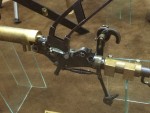
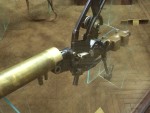
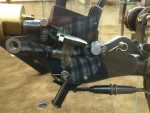
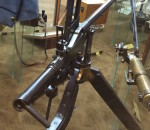

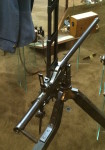

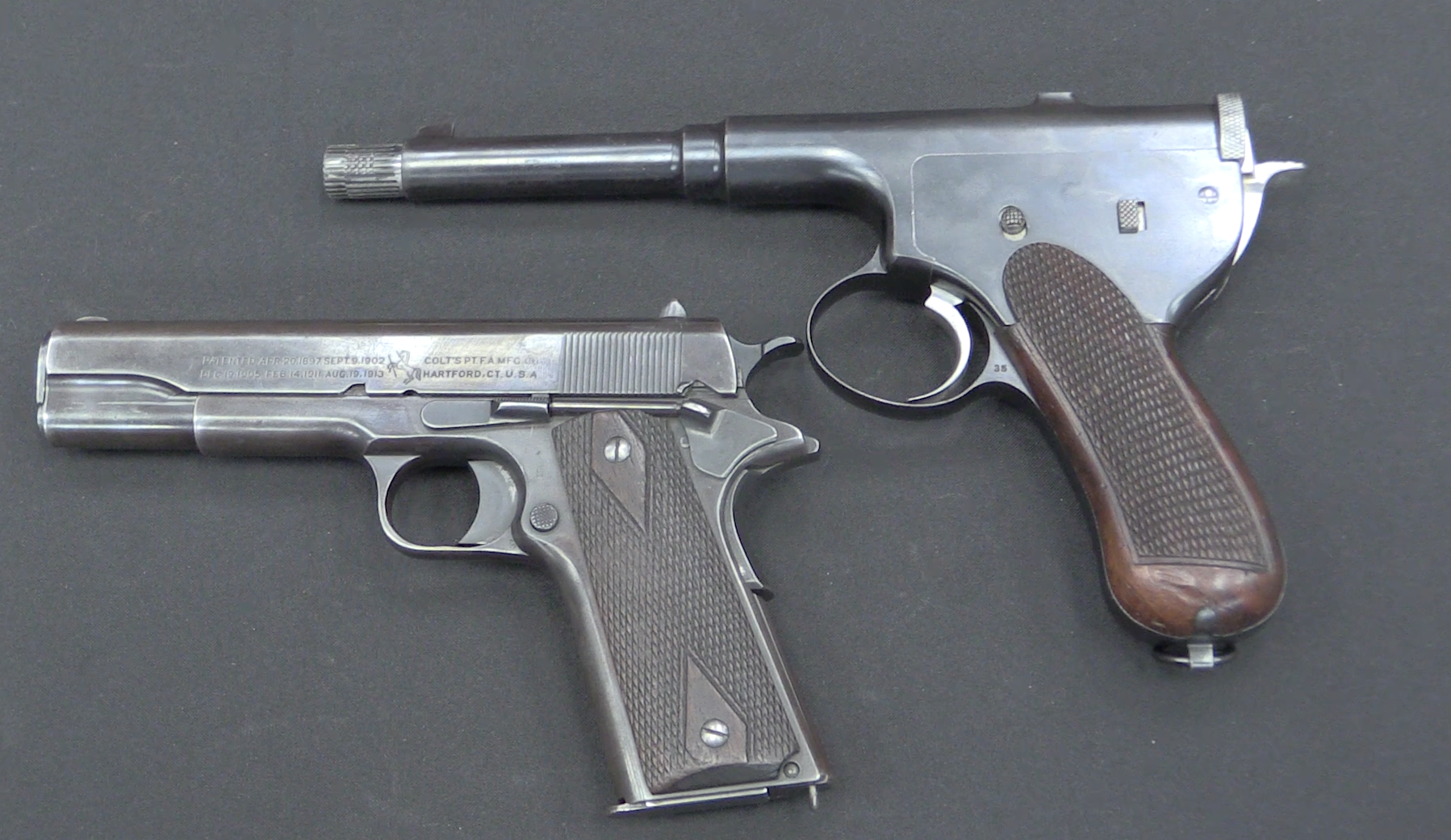
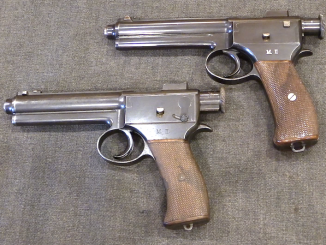
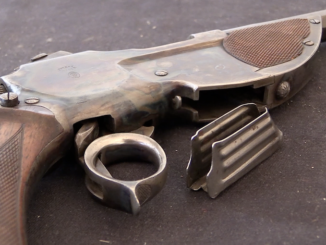
According to the 1930 Polish “Machine guns” handbook by Major Ostrowski, the actual trigger is the pendulum below the receiver, that has to be set manually in motion for the first shot, and then starts to operate automatically. The weight on it, as Ian wrote, can pace the gun.
The vertical shepherds crook thingy with a roller on top seems like a dial sight to me – note the front sight post at the brass bbl casing brace is also kinda offset to the right.
“the actual trigger is the pendulum below the receiver”
So if you want to halt firing you have to catch that pendulum? Or other method exist?
It seems the tubular handle connected with pendulum in its front with a amortiseur like engagement works as an “Action Starter/Stopper”. Its motional arc is shorter than pendulum and can be held firmly through firing.
The hook-shaped contraption appears to me as a rear sight system with elaborate range setting mechanism. The knob on the right apparently is used to rotate “hook” and set the range; the sighting notch is visible on the curved surface, and the front sight mounting bracket is visible on the right side of the jacket on photo #417 (top-front view)
Just my 2 cents
“pendulum swings back and forth with the action as each shot is fired”
Similar to Colt Potato Digger machine-gun.
“as 175 rpm and as high as 500 rpm”
Do you have these data from St. Étienne Mle 1907? wikipedia query states that lowest is 80 rpm and highest 650 rpm, that first looks incredibly low for me.
“Reportedly clips were made used a spring catch to hold cartridges”
How many cartridges were in one clip? This system has advantage over belt-feed as this gun magazine can be refilled, before all cartridges are fired.
Also then standard belts were canvas belts, which IIRC were vulnerable to moisture. Later Maxim guns (examples: Finnish M/32-33, Swiss MG 11) were adopted for metallic belt.
Couldn’t help but think “Steampunk” when seeing the Salvator-Dormus
Oh it is isn’t it, it just so is.
Didn’t Mikhail Kalashnikov make a screw breech thing, maybe he saw one of these. Sort of Schwarzlose… Not that I understand that.
With a swiveling extension on the support block which extends forward of the chamber, gas via ports could impart force on it retarding rearward motion.
Kalashnikov SMG 1942 (not to be confused with Kalashnikov SMG 1947):
https://ru.wikipedia.org/wiki/Пистолет-пулемёт_Калашникова_(1942)
торой из разработанных им образцов оружия (первый пистолет-пулемёт, использовавший отвод пороховых газов, не сохранился) The second of them developed models of weapons (first sub-machine gun, who used withdrawal of powder gases, not preserved) It says can you offer a better translation, he he.
“Sub machine gun Kalashnikov in the manufacture of more complex and expensive than the PCA-41 and PPP, and requires the use of scarce and slow milling operations. Therefore, despite the many sides to bribe (low weight, short length, the presence of a single lamp, successful combination of a translator and a fuse, a compact cleaning rod and so on.), In its present form, the industrial no interest.” Bribe? Transliteration… I hope the translators in the U.N are better, no wonder everyone looks at each other funny.
“Submachine gun had delayed blowback, which waste ago slowed due to the interaction of two pairs of screw bolt in the group: the bolt – swivel coupling and swivel coupling – screw shank. During rollback movable portion of the shutter is moved longitudinally along the guide rails of the receiver, the sleeve is rotated, and the shank is fixed – it is fixed against rotation lug within the groove on the end of the receiver. This coupling navorachivaya on the shank of the bolt is turned out. Thus the sleeve and the bolt, moving back, as it were “run away” with respect to each other, the rollback speed increases and decreases the gate time of full opening of the shutter. This scheme of automation is unique to this sample arms.” Thank you for the link anyway Sergei.
“This scheme of automation is unique to this sample arms”
Not, screw-delayed blow-back is also principle of operation of DEMRO TAC-1
https://en.wikipedia.org/wiki/Demro_TAC-1
Ah, hmmm… Most interesting Daweo thanks.
“Bribe? Transliteration… I hope the translators in the U.N are better, no wonder everyone looks at each other funny.”
I don’t know that this story story is true, but it sounds possible:
During Cold War Russian-English, English-Russian translator was developed for US intelligence, one of tests was: put English phrase in RU-EN part than put result of it in EN-RU part, result was interesting:
INPUT: The spirit is strong, but body is weak.
OUT: Vodka is good, but flesh is rotten.
One of the meanings of the verb “to bribe” (подкупить/подкупать) in Russian means to entice, to win over. Example: “What “bribed” me in his proposition was its simplicity and concision, as well as the stated potential to save on materials and increase efficiency”.
So in this excerpt, the writer meant “Therefore, in spite of multiple winning aspects of the design, in its present form, it does not show promise (“does not invoke interest”) for mass manufacture.”
More photos:
http://lenta.ru/photo/2013/12/23/kalashnikov/#0
And here:
http://www.sinopa.ee/kalashnikov/r9899/ruzjo0199/ruz019930/ru019930.htm
Pictures paint a thousand words, cheers 🙂
Good that isn’t it, nice system.
I think that hooked vertical lever is a rear sight, with a turning wheel for elevation. The front would be mounted in the hole on the water jacket band.
Attrition… The U.S winning tactic in the civil war, WW1 the Somme. “I read this, it’s not an epiphany” but it makes sense. Basturds, I mean it won, but like… Surely we could have, whatever. Ze German Blitzkrieg is explained thus in WW2, they understood their trained army was neutralized in that battle and they didn’t intend to repeat it. Seemingly, we did intend to “charming” but adapted. It is relevant, machine guns etc.
Hmm… The Fiat-Revelli Modello 1914 also had a circulating pump rather than a condensing vessel. The Salvator-Dormus later had a weird belt-feed, if I’m not mistaken…
The breech system of the S-D resembles that of the Remington-Rider rolling-block single-shot rifle in principle. If you thing of the “support block” as the hammer of the rolling block, reinforcing the breechblock at the instant of discharge, it becomes pretty obvious. Even though the supporting block works more like the breechblock of a Peabody-Martini.
That open-framed gravity-feed magazine has always puzzled me. The 8 x 50R Austrian Mannlicher round has about the dimensions and profile of other rimmed “smallbore” rounds of its day, like the 8 x 58R Danish Krag, 8 x 60R Portuguese Guedes M85, 8 x 53R Murata, etc.
Like them, it has a distinct taper. Not as much as an 8 x 50R Lebel, but it’s there.
I would expect a magazine or hopper feed for a round with that profile to “bend the other way”- like a Bren or Madsen magazine.
I suspect that this hopper feed might have been fairly prone to getting rounds dropping into the lower section with the noses cocked up- a sure way to cause a stoppage (feed-phase “smokestack” aka “church-steeple” jam).
This may have been why the U.S. Army wasn’t too impressed with it.
cheers
eon
I found an image that could be relevant:
http://f-picture.net/fp/64699600cce640148b64ed95ee421695
That thing right in the middle with the spring-loaded plunger appears to be the trigger unit.
Directly to the left, you can see how it works – when the plunger is down, its tip stops the feed block.
Actual needed clearance for a delay mechanism to prevent case seperation or burst, or swell, is the distance of a few milimeters from the breech end of barrel. Therefore, it is fairly hard to obtain this delay with the solely push movable screw steps. Its delay value should be on the slowing effect of the breechboolt motion to get a softer recoil kick like the function of recoil spring. On this particular firearm, real delay effect should be obtained by the rolling breechbolt working as an accelerator for the support block and sharing the gained momentum as to give speed to support block and to give the delay for rolling breechbolt, just like being on Lever or Roller Delay mechanisms. IMHO.
It’s simply an amazing looking gun, more like a time piece than a machine gun.
The accounts seem to imply that the gun(s) were used either in the defense of or the relief of the Legations in 1900. They’re also ambiguous enough to allow for the guns to have stayed on board ship and to have been used against the defenses at Taku(?) “55 Days at Peking” was on on TCM not too long ago. Needless to say, there was no Skoda gun featured in the film.
I just wanna ask if Ed lives in Austria, or did he just visit the HGM back then?
This image shows the Salvatore-Dormus with a metal shoulder stock with what appears to be a trigger attached to that:
http://getwar.ru/wp-content/uploads/2011/05/m02-i-m13.jpg
It looks like it simply holds the pendulum in the rearward position.
Interesting – but I think that’s a later model, the water jacket seems thicker, the top of the hopper looks different, and the weight on the pendulum appears to have a different shape as well.
Pseudo-edit:
On second look, I’m not sure that’s actually a trigger at all – I think it’s just the crank handle, that happens to be in line with the pendulum in the photo.
The Heeres Geschichtlichemuseum, which I think I spelled correctly, (Army History Museum) in Vienna is AMAZING. I had the opportunity to spend a couple hours there while in Vienna on business last year.
The Napoleonic to WWI-era small arms collection is unbelievable (WWII is well-covered also, but I think many other museums cover that just as well). Plus medieval arms and armor. Plus the conning tower of an Austro-Hungarian navy submarine, aircraft, etc.
I took a photo of this weapon, among many others, during my visit and looked it up. Yes, very steampunk!
The centerpiece of the collection there, though, is the vehicle that Archduke Franz Ferdinand was riding in the day he was assassinated, along with his pregnant wife, in 1914. Along with his uniform from that day. And the four Browning Model 1910 7.65mm pistols used (the actual one that Gabril Princip used is not known, it’s one of the four he and his co-conspirators had). Exactly two rounds were fired, and they resulted in two fatalities that had such huge consequences.
Sorry for going on the tangent about the museum but if you are anywhere near Vienna you really should go.
Theres a rare pic on this page of the guns loaded with their gravity feed magazines and the magazine carriers,it also shows just how tall the magazine and its guide actually was despite the very compact nature of the rest of the gun.
https://sassik.livejournal.com/590164.html
Theres also a great shot of a naval mounted version minus its magazine guide which really shows off just how compact this early machine gun actually was
https://ic.pics.livejournal.com/fvl1_01/13501116/47201/47201_original.jpg
And heres a neat old postcard showing the gun set up on its tripod loaded with a magazine with its operator.
https://static.auction.ru/offer_images/2018/08/13/01/big/L/LXMLgFTP1O9/soldaty_s_pulemetom_avstrija.jpg
These photos are great, they seem to answer some of the questions above. Thanks for posting!
offtop: Zenta is a light “protected” cruiser, not a “battlecruiser”